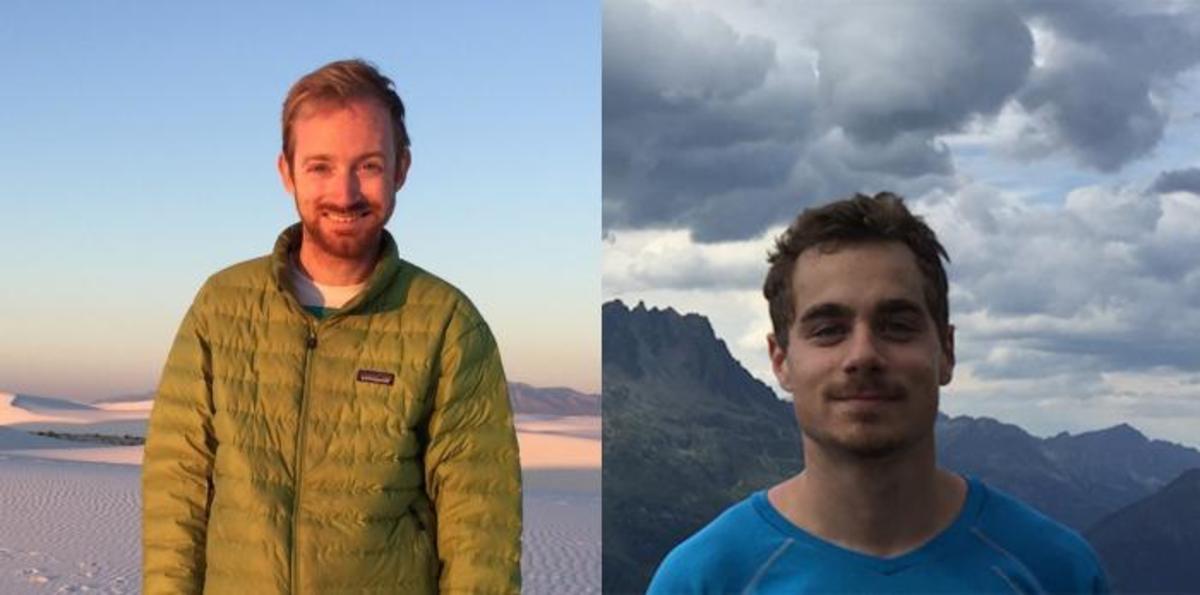PAOC Spotlights
Brian Green and Tom Beucler Receive the Rossby Award 2018-2019

The Program in Atmospheres, Oceans and Climate (PAOC) within MIT’s Department of Earth, Atmospheric and Planetary Sciences (EAPS) congratulates Brian Green PhD ’18 and Tom Beucler PhD ’19, who share the award for best for best doctoral thesis done the preceding year within the program.
The honor is named after former MIT Professor Carl-Gustaf Rossby, who established meteorological research at MIT that morphed into today’s PAOC. It recognizes scientific excellence in the next generation of researchers.
Co-advised by EAPS professors Tim Cronin and Kerry Emanuel, Tom Beucler’s thesis work sought to connect theory, high-resolution models and observations to understand the temporal and spatial scales of water vapor patterns in the tropics. As the resolution of climate models improved over the years, they began to show that clouds started to cluster together affecting the local meteorology and the overall energy budget of the atmosphere. While the terabytes of climate model data contained a wealth of information, they did not allow researchers to establish causality. Therefore, Beucler "used idealized models to hypothesize that this clustering was due to the interaction between upper-atmospheric water and atmospheric radiation. This motivated a simple method to summarize and explain the clustering patterns of atmospheric water in the tropics across models and observations.”
Beucler is now a project scientist in atmospheric science affiliated with the University of California, Irvine and Columbia University working at the intersection of atmospheric physics and machine learning to build data-driven models of clouds and convection to explore new scientific grounds and refine climate projections.
“The Carl-Gustaf Rossby Prize Committee, which this year included Stephanie Dutkiewicz, Kerry Emanuel and Ron Prinn) was very impressed by this work. "Tom's thesis nailed down the physics that lead to the spontaneous aggregation of moist convection and developed new ways of diagnosing such physics."
“Although each discovery was rewarding, it was almost always overshadowed by the next pressing research question,” Beucler says reflecting on his research experience. “Winning the Rossby prize helped me pause my new projects for a moment to look back and appreciate what may have been the four most stimulating years of my life.” He thanks his advisors and credits PAOC’s passionate and motivated student body for their encouragement to explore different ways of tackling atmospheric dynamics questions. “I am especially grateful for the atmospheric science community at MIT which was certainly the key to my success.”
Brian Green’s work with professor and advisor John Marshall also focused on the tropics, in particular how the ocean’s circulation interacts with Hadley cells in the atmosphere via the trade winds, affecting rainfall distribution near the equator. He was investigating if the rainfall pattern of the intertropical convergence zone (ITCZ) shifts or strengthens independently of the ocean circulation, or if the ocean constrain the dynamics of the former. They found that the ocean holds the ITCZ close to the equator and plays a significant role in controlling the strength of the atmospheric circulation. “The subtropical cells, because of their coupling to the atmosphere by the trade winds, do this by transporting relatively large quantities of heat, controlling the atmosphere's energy balance,” Green says.
"Brian's thesis makes a compelling case that ocean dynamics damp shifts in the ITCZ shifts by roughly a factor of 2,” says the Carl-Gustaf Rossby Prize Committee in an email. “His thesis makes clear that robust damping of shifts can be expected because of the connection of ocean and atmosphere overturning cells by Ekman balance."
A postdoc at the Joint Institute for the Study of the Atmosphere and Ocean (JISAO), at the University of Washington, Green’s research still focuses on the distribution of rainfall in the tropics, which vary from region to region and season to season. But he now uses satellite data and atmospheric reanalysis to study individual precipitation events and the environment in which they occur and tries to understand this variation by relating it to the structure and circulation of the tropical atmosphere.
Green also thanks his mentors, collaborators and advisor for their support and contributions without whom this work would not be possible. “I am humbled that scientists I respect have found value in my work, and grateful for it to be recognized by a program that has already given me a career in science.”
As part of the accolade, the winners’ names will appear on a plaque in the department next to previous honorees.
Story Image: Brian Green (left) and Tom Beucler (Credit: courtesy of the researchers)